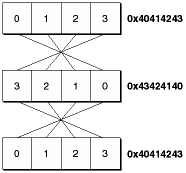PATH
Address invariance (also called byte address consistency) guarantees that individual bytes are mapped across a data bridge according to their address (or byte lane number); the address of a byte is kept the same on both sides of the bridge.
For example, the little-endian NuBus maintains address invariance when passing data between the big-endian Macintosh II computer and an expansion card. To keep track of data movement, bytes are channeled into byte lanes. Thus, byte lane 0 of the Macintosh processor bus is mapped to byte lane 0 of NuBus, and so on. But when a 32-bit word passes to NuBus, the bytes are changed in significance by a process called byte swapping. The expansion card undoes the byte swap on its side of NuBus, so that data in memory on a card is organized exactly the same way it is on the Macintosh side. The diagram in Figure A-4 shows how data is mapped from the Macintosh II system across NuBus onto an expansion card.
Figure A-4 Byte swapping in NuBus
